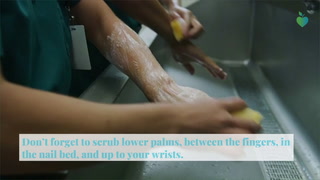Why Proper Hand-Washing Is Essential During Cold and Flu Season
Whether you use soap and water or hand sanitizer, keeping your hands germ-free can help protect you against influenza.


While it’s not foolproof, getting a flu shot is still the best way to protect yourself against influenza. And when it comes to keeping your immune system healthy, there’s plenty of advice out there on how to do so, whether that involves eating enough vegetables, getting quality sleep, managing or lowering stress whenever possible, or staying active when you can.
But good personal hygiene, starting with washing your hands several times a day, is absolutely essential to reduce your risk of getting sick or spreading germs to others.
The viruses that cause the common cold and the flu can spread easily via respiratory droplets produced when a sick person coughs, sneezes, or talks, per the Centers for Disease Control and Prevention (CDC). Personal contact like handshakes or touching contaminated surfaces such as doorknobs can also cause germs to accumulate on your hands; then by touching your eyes, nose, or mouth, you can infect yourself.
Per the CDC, respiratory droplets are also known to be one way in which the coronavirus responsible for the COVID-19 pandemic is transmitted.
“Hand-washing is the best way to prevent colds and other respiratory and infectious diseases that are transmitted by hand to mouth or hand to nose and eye contact,” says Samuel N. Grief, MD, medical director at CVS Health in Chicago. “Soap acts as a vehicle to trap the germs that are loosened by the act of rubbing your hands together under water. These germs can then be rinsed away by the water.”
The Right Way to Wash Your Hands for Flu and Cold Prevention
When it comes to preventing colds, flu, and other infectious diseases, the CDC recommends washing your hands for at least 20 seconds at a time; you can keep track of how long this should take by humming the “Happy Birthday” song twice. Use plenty of soap, and be sure to lather and scrub not just your palms but also the backs of your hands, between your fingers, and under your nails.
Don’t worry about getting the water very hot. According to research, a majority of people believe that using hot water is more efficient than washing with warm, room temperature, or cold water. But there’s no evidence to support this. Heat does kill bacteria but at a much higher temperature than is comfortable for washing your hands.
According to the study, using hot water for hand-washing not only is unnecessary but may also be problematic, since it can cause skin irritation. That may not happen with one scrub-up session, but during cold and flu season, when you should be washing your hands much more than usual, it could become an issue.
And a study published in May 2017 in the Journal of Food Protection found that water temperature was not a critical factor in removing microorganisms (like bacteria and viruses) from hands. The two key factors to effective hand-washing were found to be soap usage and duration of washing, rather than the type of soap or water temperature.
“There is no one best water temperature to wash one’s hands,” says Dr. Grief. “If your hands are really dirty and greasy, use of warm to hot water will do a better job of trapping dirt and grease within the soap, allowing for a more thorough cleaning.”
The type of soap also doesn’t typically matter, according to Grief, “as long as it lathers and spreads over the hands sufficiently to trap the germs.” While you may believe that antibacterial soap is more efficient for hand-washing than regular soap, the CDC advises that studies have not found a benefit to using antibacterial soap versus regular soap outside of a hospital setting, and that regular use of antibacterial soap may actually contribute to antibiotic resistance.
Soap cleans your hands in two ways. The first is by rupturing the lipid (or fat) membranes that surround some types of bacteria and viruses (including those responsible for COVID-19, hepatitis B and C, Ebola, Zika, and more). When this membrane is broken, it leaves these pathogens ineffective and unable to reproduce, ready to be rinsed away.
The second is by disrupting the chemical bonds holding the germs to the surface of your skin, enabling you to wash them down the drain as you're rinsing. That's also why the length of time spent lathering and rinsing matters, because you’re trying to trap and flush as many germs as possible. This method is effective for all microorganisms, not just those with a lipid layer.
7 Steps To Washing Your Hands The Right Way

Does Hand Sanitizer Effectively Kill the Flu Virus?
Experts suggest that hand-washing is the most effective way to get rid of germs that could lead to cold or flu exposure. But let's face it: You're not around a sink all the time. That's when alcohol-based hand sanitizers can be useful, since they can be a good substitute for hand-washing when soap and water are not available.
According to the CDC, sanitizers with an alcohol concentration between 60 percent and 95 percent are more effective at killing germs than those with a lower alcohol concentration or non-alcohol-based sanitizers.
But the CDC adds, they're only effective if you use them properly. Much like sunscreen, simply rubbing a bit on occasionally isn't enough to protect you if you're not using the right amount.
The right way to use a sanitizer is to apply it to the palm of one hand and rub it all over the surfaces of both hands until they’re dry. Even though alcohol-based hand sanitizers can deactivate many types of microbes when used correctly, they’re not effective if you're skimping on the amount, wiping it off before it dries, or missing key spots such as your fingertips and between your fingers.
The CDC points out that soap and water are more effective than hand sanitizers at removing or inactivating certain kinds of germs like norovirus, which is the most common cause of gastroenteritis (often referred to as stomach flu).
How Often Should You Wash Your Hands During Flu Season?
The CDC states that washing your hands often will help protect you from germs that can cause the flu and other serious respiratory illnesses. But how often is often? It will depend on your situation and how exposed you might be to other people’s germs.
If you're working from home, living alone, and not going out much, you would likely need to wash your hands less often than if you're out in public frequently, have a multiperson household, and care for someone with a compromised immune system, for example.
Rather than wash a specific number of times per day, it's more important to wash when you feel you have been at an increased risk of exposure, and that is an individual decision.
That said, regular hand-washing is especially important at certain times. Always remember to wash up:
- Before and after preparing or handling food
- Before eating
- After changing diapers
- After using the bathroom
- After sneezing, coughing, or blowing your nose
- After touching an animal or animal waste
- After handling garbage
- Before and after treating a wound
- Before and after caring for a sick person
4 Tips to Properly Washing Your Hands to Prevent the Flu
When it comes to preventing colds and flu with hand-washing, it pays to be extra thorough and go beyond the standard guidelines. Consider these tips:
1. Be thorough. Spots that people typically miss include the backs of the hands up to wrists, the lower palms, between the fingers, and in the nail bed. However, don't scrub your hands so aggressively that they end up dry and cracked. If you find that frequent hand-washing is causing redness, dryness, or irritation to your hands, set a pump-top container of hand lotion by your sink and apply lotion after washing.
2. Use a paper towel to dry. Research has noted that paper towels are more effective and efficient than electric hand dryers from a hygiene standpoint. Rubbing hands with a paper towel — as compared to air drying or using a hand dryer — can also remove some germs, so you may be getting rid of some that survived the hand-washing process. If you’re using cloth towels to dry your hands, switch them out regularly for laundering.
3. Grab another towel to prevent reinfection. After all the effort, don't reinfect your hands by touching surfaces that may be carrying germs, like the faucet, countertop, or door handle on the way out of the bathroom. Use a paper towel to turn off the water and open the door, then throw away that paper towel in the closest garbage can. If you're in a public bathroom, don't put your phone down on the sink while you wash your hands. That could cause your phone to pick up germs, and they're right back on your hands again no matter how thoroughly and well you've washed.
4. Disinfect high-touch surfaces regularly. Think about the objects and areas you and others touch frequently, and take care to wipe them down regularly with antibacterial wipes or an antibacterial spray and paper towels. In your own home, make sure you’re regularly disinfecting high-touch areas and belongings in your kitchen and bathroom: light switches, doorknobs and handles, countertops, phones, remotes, buttons, and doorbells, to name just a few. Read the instructions on the cleaning products you use to understand the difference between cleaning, sanitizing, and disinfecting.
Additional reporting by George Vernadakis.



